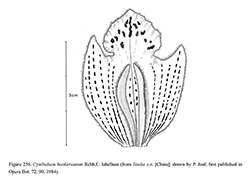e-Flora of Thailand
Volume 12 > Part 2 > Year 2014 > Page 458 > Orchidaceae > Cymbidium
10. Cymbidium hookerianum Rchb.f.wfo-0000934455
Gard. Chron. 1866: 7. 1866; Seidenf., Opera Bot. 72: 89, fig. 49. 1984; Du Puy & P.J.Cribb, Gen. Cymbidium: 192, fig. 106(4), 107, t. 19–20, map 26. 2007.— C. giganteum var. hookerianum (Rchb.f.) Desbois, Orchid: 119. 1893; Lindenia 9: 13. 1893. Fig. 256.
Accepted Name : This is currently accepted.
Synonyms & Citations :
Description : Epiphytic or lithophytic herb. Pseudobulbs 3–6 cm long, 1.5–3.5 cm in diameter, elongate-ovoid, bilaterally flattened. Leaves 4–8 per pseudobulb, sessile, up to 80 by 1.4–2.1 cm, linear-elliptic, acute. Inflorescence up to 70 cm long; rachis slender, arching to pendant, slightly flattened, bearing 6–15 flowers; bracts up to 4 mm long. Flowers up to 14 cm across, with a strong fresh scent; sepals and petals clear apple-green with some deep red spots towards the base, occasionally lightly shaded with red-brown; labellum cream-coloured, becoming greenish at the margin, flushing strong purplish-pink after pollination, side lobes spotted deep maroon, mid-lobe with a submarginal ring of red-brown blotches and spots, and a broken central line of confluent red blotches, base of labellum bright yellow with maroon spots; ridges cream with reddish spots. Dorsal sepal 56–60 by 17–19 mm, narrowly obovate, acute, porrect; lateral sepals similar, spreading. Petals 53–56 by 12–14 mm, ligulate or very narrowly obovate, slightly curved, spreading. Labellum fused to the column base for 4.5–5 mm; side lobes 11–16 mm broad, triangular, acute and porrect, margins ciliate (cilia over 1 mm long), papillose or shortly hairy especially towards the apex; mid-lobe 17–20 by 27–29 mm, broadly ovate-cordate, mucronate, recurved, papillose, sometimes with scattered hairs, never with the central lines of hairs present, margin erose and strongly undulate; ornaments of 2 ridges, tapering to the cavity at the base of the labellum, strongly hairy along the top. Column 33–40 mm long; pollinia 2. Capsule up to 13 by 4 cm, fusiform-ellipsoidal.
Thailand : NORTHERN: Chiang Mai.
Distribution : E Nepal, N India (Sikkim Assam), Myanmar, China (N Yunnan, SW Sichuan and SE Xizang); 1,500–2,600 m alt. Type prepared from a cultivated plant of unknown provenance.
Ecology : Grows as an epiphyte on trees in damp, shady forests or on steep banks or rocks, often where thick moss cover occurs. Flowering: January–March.

